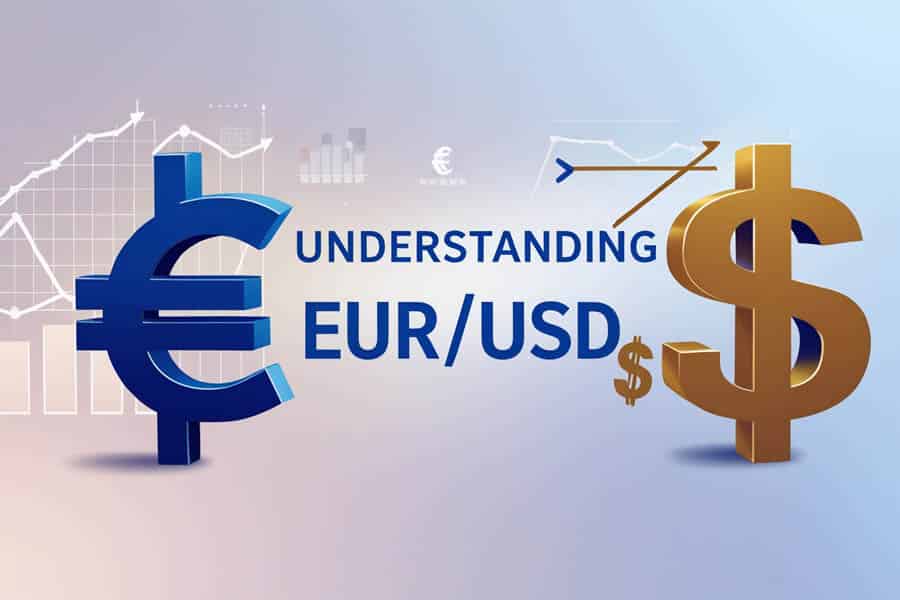The EUR/USD currency pair, often called “the fiber,” is the most traded forex pair in the world. It represents the exchange rate between the euro and the U.S. dollar, two of the largest and most influential currencies in global markets. Understanding its history and behavior is essential for anyone looking to trade it successfully.
The Origins of the Euro
Before the euro’s introduction, several European countries operated with their own national currencies — such as the German Deutsche Mark, French franc, and Italian lira. The idea of a unified European currency emerged in the 1990s with the Maastricht Treaty, which laid the groundwork for a single monetary system under the European Union.
The euro was officially launched in 1999 as a virtual currency for accounting and electronic transactions. Physical euro banknotes and coins entered circulation in 2002, replacing national currencies across the Eurozone. The euro quickly became a major global reserve currency, second only to the U.S. dollar.
Early EUR/USD Movements
When the euro debuted in 1999, it traded around 1.17 against the dollar. However, the pair fell sharply in its early years due to investor skepticism about the euro’s long-term stability and Europe’s economic growth. By October 2000, EUR/USD dropped below parity, reaching around 0.83 — its lowest historical level.
The tide turned in the early 2000s as confidence in the euro strengthened and the U.S. faced a widening trade deficit and the aftermath of the dot-com bubble. By 2008, the pair reached an all-time high near 1.60, driven by strong European exports and a weakening dollar.
Post-2008: Volatility and Divergence
The 2008 global financial crisis marked a turning point for the EUR/USD pair. The euro initially remained strong, but as the European debt crisis unfolded between 2010 and 2012, investor confidence waned. Countries such as Greece, Portugal, and Spain struggled with high debt and unemployment, leading to fears about the euro’s survival.
During this period, EUR/USD fluctuated between 1.20 and 1.50, reflecting uncertainty about Europe’s fiscal unity. The pair stabilized after the European Central Bank (ECB), led by Mario Draghi, pledged in 2012 to do “whatever it takes” to preserve the euro.
In the years that followed, diverging monetary policies between the ECB and the U.S. Federal Reserve drove large swings in the pair. The Fed’s decision to tighten policy and raise interest rates, while the ECB kept rates near zero or negative, strengthened the dollar and pushed EUR/USD lower.
The Pandemic and Recent Developments
The COVID-19 pandemic brought renewed volatility to the EUR/USD. Initially, investors flocked to the dollar as a safe haven, pushing the pair down. However, aggressive fiscal stimulus in the U.S. and coordinated European recovery efforts led to a rebound, with EUR/USD briefly surpassing 1.20 in 2020.
By 2022, inflation and interest rate hikes dominated market sentiment. The dollar surged as the Fed pursued one of its most aggressive tightening cycles in decades, while the euro struggled amid the energy crisis linked to the war in Ukraine. The pair even dipped below parity for the first time in 20 years — a rare event that reflected the euro’s vulnerability to geopolitical and economic shocks.
Things to Know When Trading EUR/USD
1. Economic Indicators:
The pair reacts strongly to macroeconomic data from both regions — including U.S. inflation reports, European GDP figures, and employment numbers. Traders closely follow announcements from the Federal Reserve and the European Central Bank.
2. Interest Rate Differentials:
One of the most important drivers of EUR/USD is the difference in interest rates between the two economies. When U.S. rates are higher, the dollar tends to strengthen as investors seek better returns, and vice versa.
3. Political and Geopolitical Events:
European elections, U.S. fiscal policy, and international conflicts can all move the pair dramatically. For example, Brexit and the Russia-Ukraine war both had significant impacts on the euro’s value.
4. Trading Volume and Volatility:
As the world’s most liquid currency pair, EUR/USD offers tight spreads and frequent price movement, making it ideal for day traders and long-term investors alike. However, liquidity can thin during holidays or unexpected news events, leading to sharper price swings.
A Dynamic Barometer of Global Markets
The EUR/USD pair is more than just a currency quote — it’s a reflection of the balance of power between the world’s two largest economies. For traders, understanding its historical context and the forces that drive it is crucial to navigating the forex market successfully.
While short-term trends often hinge on rate decisions and data releases, long-term movements in EUR/USD tend to mirror broader economic cycles and global confidence in the transatlantic alliance. In that sense, it remains the ultimate gauge of global economic sentiment.







